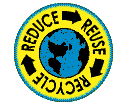Students
Go Green this School Year

Seven Tips to Start your School Year Green
- For every 42 notebooks made with 100 percent recycled paper, one tree is saved. Find more green Back to School shopping tips to help protect the environment.
- 30 percent of all waste generated comes from packaging. Many supplies can be reused or recycled such as pens and notebooks. What’s your Quest for Less this school year?
- Every year in America, 10.5 million school days are missed due to asthma. Work with your child's doctor to create a written Asthma Action Plan for managing you child's asthma and share it with your school.
- Raise a flag for air quality awareness. Download the Air Quality Index app on to your mobile device and start a School Flag Program.
- American schools spend $6 billion each year on energy, more than what is spent on textbooks and computers combined. Teach kids to be Energy Stars by becoming more energy efficient!
- Teachers: when cleaning the classroom look for the DfE label on cleaning supplies to find safer products for students and the environment.
- Test your WaterSense: leaks can account for 10,000 gallons of water on average wasted in the home every year, which is enough to fill a backyard swimming pool. Learn the simple steps you can take to save water and money at home and school.
- Before starting a new school year, sort through the school supplies on-hand. Many things, like notebooks or pens and pencils, can be reused or recycled. You can share your used books and other school supplies with friends, relatives, or younger schoolchildren.
- If you are purchasing new school supplies, look for items made out of recycled materials. Did you know you can get pencils made out of recycled jeans or money!
- For school proms, dances, or other events, decorations and other supplies can be borrowed or rented. If you buy these supplies, try adopting a theme that can be used from year-to-year, so that you can reuse them.
- Many schools reuse text books to save money and reduce waste. Covering your textbooks with cut-up grocery or shopping bags helps reduce waste and keeps your books in good condition.
- If you buy lunch, take and use only what you need: one napkin, one ketchup packet, one salt packet, one pepper packet, one set of flatware. Remember to recycle your cans and bottles, and separate your waste if your school has separation bins!
- Help your school start or improve an existing recycling/composting program.
- Create school hall monitors that patrol for lights out in rooms not being used…you could even give your teachers report cards on how energy efficient they are!
- Take a reusable bag while shopping for school supplies or groceries
- Use both sides of the page when taking notes
- Bring lunch or snacks in reusable containers
- Drink from reusable bottles
- Use a flash drive instead of printing and toting assignments to and from school
- Save gas and make friends by carpooling
- Use a desk lamp for late night studying; don’t light up a whole room
More tips:
What else can you do ?
Read about a winning school whose students greened their way to a President's Environmental Youth Award..
Want to make your school green?
Check out these links for more information on Green Schools:
Some of the sites listed on this page are not on the EPA Web site. Please see our disclaimer information ![]()

